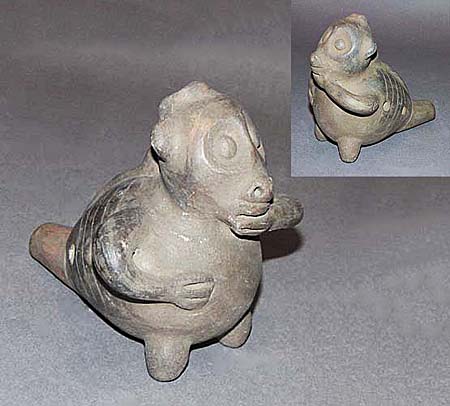
Owner: HWMC
Catalog#: LA-AEWF-01
Edge Blown Flutes
Mexico ‘Veracruz Monkey Ocarina’
Veracruz, Mexico
Veracruz Culture
Terracotta
ca. 600-800 CE
Height: 3.5 in; Width: 4 in
Aerophones – Wind Instruments Proper – Edge Blown Flutes
A Pre-Columbian four-hole ocarina from the Gulf Coast of Mexico, Veracruz (Vera Cruz) culture, ca. 600-900 CE. This hand-made pottery whistle depicts a monkey standing on two legs with one of his hands resting under his chin. There are incised markings surrounding the body, and a short-extended tail as the mouthpiece. The terracotta surface shows a strong, smooth glaze finish from the firing of the clay.
The ocarina is a ‘vessel flute’ that appears throughout the world but is commonly found throughout the Amerindian cultures in Mexico and Central and South America. There are many variations, but generally it has a small open space that traps air, with a mouthpiece that enables one to blow into the enclosed space much the same as blowing into a whistle. Often there are several finger holes for the performer to open or close to change the notes/pitches. A characteristic of the ocarina in an agricultural society such as the Veracruz culture, is the use of clay for these instruments that is molded from a single material into either a zoomorphic (animal) form, as seen here in the shape of a monkey, or anthropomorphic (human) form. The role of the ocarina has been explored but is still being researched and documented. One theory is that they were used in helping the priest or shaman to communicate or cross over between the living world to the spirit world. Spanish colonists have also noted the use of special shrines for musical wind instruments and the playing of ocarina-like whistles and flutes to announce ritual dancing and chanting.
